Indiana Population Projections, 2005 to 2040
Over the next 35 years, the number of Hoosiers age 65 and older will increase by 90 percent. That means that in 2040, one in five Hoosiers will be of traditional retirement age. Meanwhile, the number of people in the 25–54 age group—a key labor force demographic—will decline.
These are just a few of the insights from the recently released state and county population projections by the Indiana Business Research Center. Other highlights include:
- Indiana will add roughly 940,000 residents by 2040—a 15 percent increase from 2005.
- Indiana's population will surpass 7 million in 2030.
- Sixty-five of Indiana's 92 counties will increase in population.
- The 10-county Indianapolis metro area will account for 54 percent of Indiana's growth.
Indiana's Aging Population
The primary force behind Indiana's changing population dynamics is the inevitable aging of the baby boom generation. At present, this group is between the ages of 44 and 61 and, by 2030, this entire cohort will be of traditional retirement age. This fact promises to transform the state.
Figure 1 illustrates the share of total population that several age groups will hold over the next 35 years. The share of population age 65 and older will increase from roughly 12 percent of the total to nearly 21 percent. During this period, the 65 and older population will surpass the 0–14 and 15–24 age groups on its way from the smallest to the third largest of these segments. Each of the other age groups will see its share of total population decline by 2040.
Figure 1: Projected Share of Total Population by Age Group, 2005 to 2040
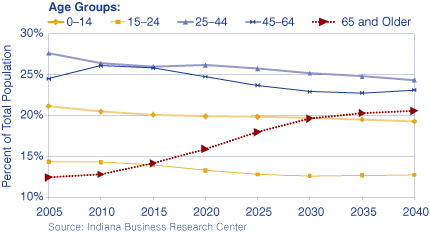
An aging population is not unique to Indiana, of course, but is a national trend. In fact, when compared to the rest of the nation, Indiana is relatively young with a 2006 median age of 36.3, which ranks in the bottom third of all states according to the U.S. Census Bureau. The state's median age is expected to increase to 39.8 years by 2040.
There is a wide disparity in aging patterns among Indiana counties. In 2005, the youngest counties exhibit one of two primary characteristics. There are major college student populations in Delaware (33.5 percent), Monroe (27.9 percent), and Tippecanoe (27.7 percent) counties. Meanwhile, there are sizable Amish and Mennonite populations that tend to have higher fertility rates in Adams (33.4 percent), Elkhart (33.4 percent), and LaGrange (29.8 percent) counties. Each of these counties will age modestly over the next 35 years, with the exception of Adams County, which will be one of six counties to get younger over the next three decades.
At the other end of the spectrum, 10 counties had a median age of 40 or older in 2005. These counties are largely rural. As Figure 2 shows, many Hoosier counties will age significantly. The number of counties with a median age of 40 or above will increase from 10 in 2005 to 69 in 2040.
Figure 2: Projected Distribution of Counties by Median Age, 2005 to 2040
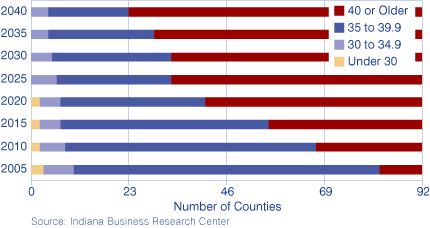
With 75 percent of Indiana's counties exhibiting a median age of 40 or above in 2040, how is it that the state's median age will remain below 40? Aging in Indiana over the next three decades will be more pronounced in rural areas of the state. Marion County, which is home to one of every seven Hoosiers, will have a median age of 37 in 2040. Other urban counties such as Allen, St. Joseph, Vigo and Hamilton will also be below 40.
Implications of an Aging Population
This inevitable aging trend could have some serious impacts on Indiana and its economy. First, will Indiana have the labor force to grow, or even maintain, its current level of economic activity?
Figure 3 highlights the percent change from 2005 to 2040 in the 25–54 age group for Indiana as a whole as well as for counties in metropolitan statistical areas and those that are not. Indiana will see a steady decline in this important labor force demographic over the next 15 years before it rebounds from 2020 to 2040.
Figure 3: Projected Change in the 25–54 Age Group, 2005 to 2040
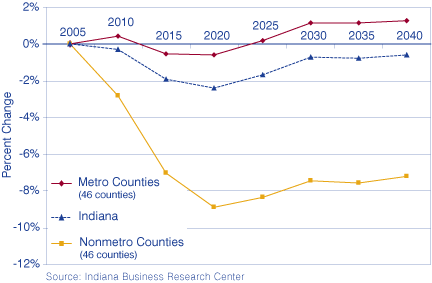
Metropolitan areas of the state will experience a similar, less drastic trend. Urban areas will see the 25–54 age group decline slightly between 2010 and 2020 before it begins to exceed current levels in 2025 and beyond. The most alarming development is the likelihood of a 9 percent decline in this age group in rural Indiana by 2020. These labor force realities, which will be faced by much of the United States, could hinder prospects for Indiana's economic growth over the next 20 years, particularly in rural areas of the state.
Decreased economic activity as a result of a shrinking labor force is by no means a certainty for our state. This decline could be offset by increased migration (both domestic and international), reduced out-migration (brain drain) or increased productivity. Additionally, there is a growing belief that many baby boomers will continue to work—whether by choice or necessity—into their retirement years.
There are other implications of an aging population. For instance, the 15–64 age group traditionally bears the financial burden of supporting the non-working residents through costs associated with raising children or supporting pension funds, social security and health care programs. Figure 4 describes the growth of the 0–14 and 65 and over age groups relative to the working age population. This relationship is often referred to as the dependency ratio. In 2005, there were roughly two working aged Hoosiers for every dependent (a 2-1 ratio). This ratio will drop to approximately 1.5-1 by 2040 and will place increased pressure on the labor force.
Figure 4: Projected Dependency Ratios, 2005 to 2040
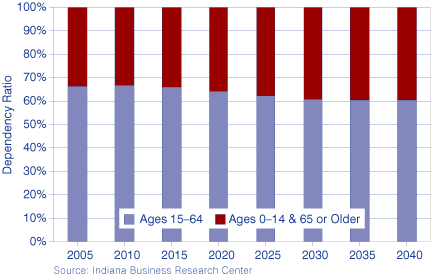
Patterns in Population Change
More than half of Indiana's growth by 2040 will take place within the 10 counties that constitute the Indianapolis metro. In fact, five Indianapolis suburban counties can expect to grow by more than 30 percent, led by Hamilton County with an astounding projected increase of 85 percent. Figure 5 illustrates the anticipated population change for all Indiana counties over the next 35 years. Northeast Indiana is another region which can expect to see significant growth with LaGrange, Elkhart, Adams and Allen counties each projected to increase by more than 20 percent. Meanwhile, 27 counties are likely to have fewer residents by 2040.
Figure 5: Projected Percent Change in Population, 2005 to 2040
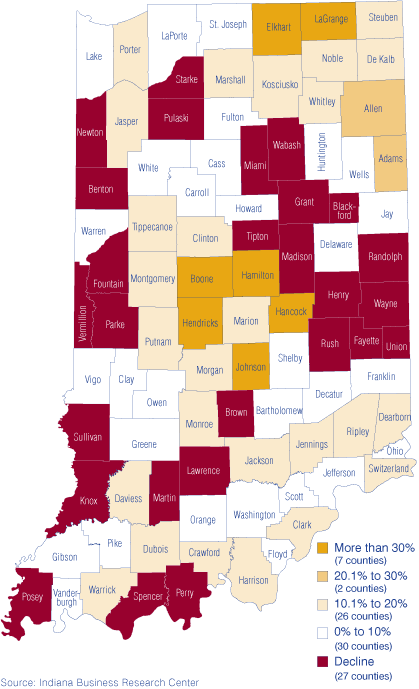
About the Projections
It is important to keep in mind that these projections are purely demographic, meaning that they rely exclusively on recent birth, death and migration trends. Therefore, these figures are a reflection of what Indiana and its communities will look like if past conditions persist. No assumptions have been made about future economic or environmental conditions.
Also, population dynamics, particularly migration, can be difficult to predict. Long-range projections can be subject to significant error. Therefore, it is often useful to pay greater attention to trends during the next 15 to 20 years.
To access the entire population projection dataset, please visit www.stats.indiana.edu/topic/projections.asp.
Matt Kinghorn,
Demographer
Indiana Business Research Center, Kelley School of Business, Indiana University
